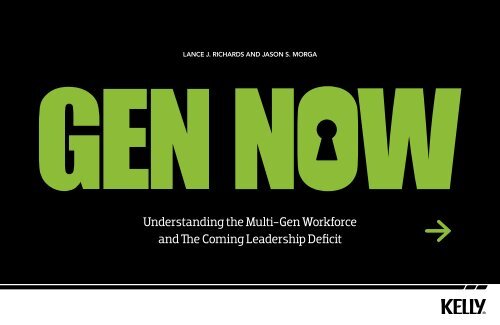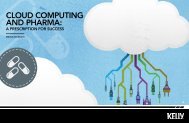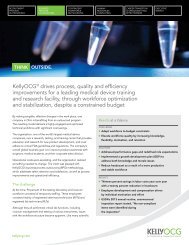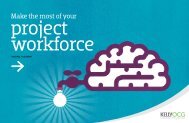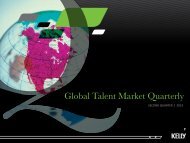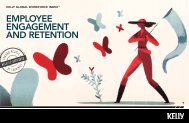Download Full Ebook PDF - KellyOCG
Download Full Ebook PDF - KellyOCG
Download Full Ebook PDF - KellyOCG
Create successful ePaper yourself
Turn your PDF publications into a flip-book with our unique Google optimized e-Paper software.
Lance J. Richards and Jason S. MorgaGen NowUnderstanding the Multi-Gen Workforceand The Coming Leadership Deficit
Introduction /02You’ve read plenty about the challenges presentedby the multi-generational workforce.You get it. The generations arewired differently, they workdifferently and organizationshave to adapt or they’ll go theway of the dinosaur.
Introduction /03Improving productivity, reducing turnover and building your talent supply chain acrossfour diverse generations is imperative for organizational success as we stare down thebarrel of a rapidly changing workplace and marketplace.There are fundamental reasons why organizations, not just HR departments and HRleaders, must respond to generational issues—and quickly.The fact is, although there is a deluge of anecdotal evidence suggesting that thedifferent generations’ mindsets and approaches to work are worlds apart, we now knowthat the modern workplace is occupied by a constituency that—across the age spectrum:• demands flexible conditions and work-life balance,• thrives on collaboration and entrepreneurialism, and• at once craves knowledge and is qualified to impart it.Today’s workforce needs to believe in its employer and perceive meaning in itswork, too.
Introduction /04Where once we may have been daunted by the prospect of the much-maligned andlittle-understood Gen Y, or the Millennial generation, representing 44 percent of the USworkforce by 2020, our research indicates that this demographic brings a fresh approachto the workplace. In combination with the experience and knowledge of the generationsbefore them, this could be the exact solution business needs.The simple truth? If leaders can adapt their mindsets and processes toembrace genuine integration of the learning and leadership styles ofBaby Boomers, Gen Xs and Gen Ys, they will bolster their success—andresilience—in the changing world of work.
05Gen Y, or the Millennial generation, will represent44 percent of the US workforce by 2020Source: Bureau of Labor Statistics; BLS Monthly Labor Review, January 2012
06A look at the multi-gen workforce2013 2020Gen YGen XBaby BoomersSilent GenerationGen ZSource: Bureau of Labor Statistics; BLS Monthly Labor Review, January 2012
07aA new workplace,newworkforce
A new workplace, a new workforce /08There are a number of social and economic factors thathave combined to define the modern workplace andthe workforce that embodies it.The modern workplace is defined by the looming skills shortage, caused in part bydeclining workforce, which is a global phenomenon taking place in all industries.More than seventy-eight million Baby Boomers are being followed by a far smallercohort of forty-five million Gen X workers, so there will be a shrinking pool of primeagedworkers to fill the gaps. The demand for talented Gen X leaders will increase, butthe supply will decrease.As well, people are remaining in the workforce longer than they used to and notjust because their pension plans took a beating in the global financial crisis. Besidesfinancial pressures, the prospect of post-work boredom is chief among the reasons thatpeople delay retirement, or opt for flexible or temporary work past retirement age.
A new workplace, a new workforce/09The skills shortage is also attributable to organizations’ inability to retain top talent.Worldwide, 43 percent of workers are considering quitting their jobs. 1 Gen X isfrustrated with lack of opportunity for advancement, 2 and even highly experienced andknowledgeable Baby Boomers are still slipping through organizations’ fingers.In short, there will still be a significant deficit in leadership capabilities and thecompetition for older, more experienced leaders will increase.Then there is the arrival (with a resounding thud!) of Gen Y, who by 2025 will constitutea whopping 75 percent of the global workforce. 3Unfortunately, not only are traditional corporate structures out of step with the wayGen Ys want to work, but the recession has forced Millennials to walk the paths ofnon-traditional employment 4 and education. This has forever altered this generation’sperception of what ‘work’ is and, unsurprisingly, has prevented them from being ableto just ‘fall in’ with the career status quo. In Australia alone, this generation has anannual job turnover rate of 40 percent, with two-thirds of Gen Y workers up and leavingeach job they hold within two years. 51 2013 Kelly Global Workforce Index Key Insights presentation2 http://www.evolvedemployer.com/2012/01/18/why-companies-cant-ignore-gen-x/3 http://www.forbes.com/sites/85broads/2012/01/23/gen-y-workforce-and-workplace-are-out-of-sync/4 http://www.forbes.com/sites/85broads/2012/01/23/gen-y-workforce-and-workplace-are-out-of-sync/5 http://www.myrecruitonline.com/events-news/MyRecruitOnline_Gen_Y.html
A new workplace, a new workforce/10One workplace, multiple generationsClearly, a multi-generational workforce requires trans-generational solutions: thediversity of experience and knowledge offered by four distinct generational mindsetscan provide tangible benefits if leveraged and managed well. The challenge foremployers is to embrace the talent mix, tap into it, and use its strengths to deliveroperational performance.The current practice of working longer and harder is unsustainable for many reasons,but its detrimental effect on employee wellbeing and, ultimately, the bottom line willcertainly have the greatest impact on the overall health of an organization. And, wehave at least one generation of workers – now the dominant one – who reject thispractice altogether.
11What definesGen Y?
What defines Gen Y? /12Before we start talking about Gen Ys as though they come fromanother planet, it’s important to know how they grew up—and theimpact this has had on their approach to work.One of the key differences between growing up in the mid-1980s through to the 1990sand the 2000s (as opposed to previous decades), has been the way in which childrenhave experienced self-directed play and, more importantly, risk and freedom.Many studies and articles have discussed the increased emphasis during recent decadeson the following elements of parenting and education:• risk aversion• positive feedback• adult or parental supervision during play, then during school and now at workYes, we need constantfeedback, that’s part of whowe are, and it’s part of whatwe’re used to from postingthings on social media.Tools like Facebook are justso powerful. Through them,I’m exposed to the details ofhundreds of people’s livesevery second of the day.I’m constantly seeing howthey’re progressing and itmakes me reflect on myown life and ask myself,‘How can I be better?’”Freelance director, Australia(i.e. helicopter parenting).Fundamentally, these parenting and educational trends have changed the way peoplenow behave in the workplace. And, while older workers have been trained to focus onissues of fairness and uniformity in their management style, in many ways this reinforces(rather than bridges) the generational divide.
What defines Gen Y?/13Technology and instant feedbackIn understanding the foundations of Gen Y, we cannot ignore the role of technology.While technology has influenced all of us, Gen Y has evolved with technology as alife center. It has particularly influenced their communication styles—Millennials havedeveloped a new version of community, friendship and connectivity.Gen Ys ability to build, shape, dismantle, evolve and grow networks quickly and easilyis one thing. But their ability to create networks that are genuine forces for change issomething else entirely. We often minimize social media as pure entertainment—it’snot (the Arab Spring proved this). And, proficiency in using it is a skill that has genuineapplication in the workplace.Gen Y have been parented and educated differently, and as a result they tend to valueand expect the following:• constant feedback• connectivity• self-expression• opportunity and reward for a job well done.
What defines Gen Y?/14Connectivity is meaningMembers of Gen Y place a high value on connections. In fact, a recent Cisco reportfound that more than half of students felt that they could not live without the Internet.From their earliest childhood, members of Gen Y have used technology and devices toconnect them with learning, knowledge, information, entertainment—and people.Just as many Ys were entering their high school years—when they were laying thefoundations of their peer-to-peer relationships—the Internet quite quickly transformedinto an environment of ‘user-generated content’ and individual expression.So, connectivity and self expression is what Ys expect. They are the ‘now’ generationand the ‘me’ generation because they can be—and it has made them more open, lessconcerned with privacy and often less likely to keep their opinions to themselves.As a digitally connected generation, Gen Y has also been afforded the luxuryof exploring diversity for much of their formative years. This understanding andappreciation of cultural difference and inclusion has exposed them to social issues anddiverse needs.
What defines Gen Y?/15Yet, consider how different these expectations and experiences are from what theaverage workplace actually delivers. When social media posts elicit immediatefeedback yet career reviews occur only once or twice per year, Gen Ys experience amajor disconnect.If we underestimate this ‘validation/feedback gap’ we will have a serious slide inmotivation on our hands.Gen Ys are also far less inclined to ‘get’ hierarchies, or to take them at face value. GenYs much prefer intricately, although fully, connected, cross-functional ways of operatingregardless of location, rank or role. They prefer dialogue and informality, which is instark contrast to how many businesses communicate.While organizations large and small have focused their efforts on developing thekind of one-way, top-down monologue that favors platitudes over specifics andtransparency, Gen Y has led the charge in communicating on every topic—fromthe Boston bombings to Bieber—in just 140 characters. They have had much moreexperience with making productive connections across traditional boundaries and aregenerally more participative.The Gen Y reach is global, 24/7 and it will join any conversation that seems relevant orinteresting, ready or not.
16Generational mindset differencesBaby BoomersGenerations X and YWork-Life Balance ‘Live to Work’ ‘Work to Live’Job Stability Seek job stability, security Are comfortable with job changesJob ExpectationsRespect AuthorityExpect to have and to earn rewardsQuestion formal authorityWant immediate payoffsDemand change and funTechnology Learned as adults Technologically savvy
17matterTrust and dialogue
Trust and dialogue matter /18In the experience economy, where Gen Ys live, we don’tdeliver goods or a service, we deliver an experience.The same applies at work.Just as the act of unpacking your latest i-device is an experience Apple has deliberately‘created’, the experience of a workplace must also be deliberately built and deliveredon a daily basis. And, a large percentage of this ‘delivery’ falls in the lap of themanager/supervisor.Getting this right for younger workers isn’t always easy. It often requires challengingspecific traditions and entrenched ways of operating, but it’s non-negotiable if buildinga talent supply chain across this age group is a genuine goal.The flow of information, the ease and quality of connections and collaboration, thefacilitation of self-expression and feedback are all experiences that directly impact theway Gen Y workers feel about their workplace, and their place within it.Some organizations havevery rigid rules aboutwhom you can speak to ifyou have an idea or want tofix a problem. It’s frustratingwhen I have an idea butcan’t go directly to theperson it’s most relevantto. As I see it, it’s a waste oftime for the organization ifmy direct manager has toget involved to progress asolution. It devalues ideas;they should be taken onmerit, not based on whohas them.”Communications advisor,AustraliaOur research—empirical, experiential and anecdotal—suggests that Gen Y may havethe most highly refined BS detectors ever.
Trust and dialogue matter /19Members of Gen Y are far less likely to believe what you say unless they can verify itindependently via other sources. Trying to hide, ignore or gloss over negative mediacoverage or customer feedback about your organization’s activities or products is asure-fire recipe for disengagement and distrust. Gone are the days when the CEOcould put out an internal statement (written by the PR department) about an issue inthe media and expect the workforce to accept it. Organizations now need to engage ingenuine dialogue.Members of Gen Y make it their business to seek out people they trust and relateto—they don’t always assume this will be their direct manager. They take personalresponsibility for finding information and people through their networks—and this cansometimes be misconstrued as undermining authority, or an inability to work withinassumed processes. But often, that’s not it at all.They seek information differentlyTwo employees of different generations simply use different skills to achieve thesame ends. For example, if you ask an older person to find out how to do something,they will head straight to Google and start trawling the search results—and we allknow that this can take seconds or hours. A Gen Y or Gen Z on the other hand might
Trust and dialogue matter /20try Googling first, but if the result isn’t there immediately, they’ll reach out to theirnetworks instead. They will post a question to Twitter, Facebook or any other networkthey feel may hold the answer. They will rely more and more heavily on crowd-sourcinganswers, particularly as networks become more sophisticated and intelligent inassisting with this task.The reality is that the concepts of ‘open source’, of ‘self-as-publisher’ and of socialnetworks as ‘democratizing forces’ have been developed and honed by Gen Ythroughout their teen and young adult lives. As foundational aspects of how they thinkand behave, they’re not about to leave them at the office front door each day. Besides,Gen Z has been thinking and behaving in these same ways since elementary school.In short, we ain’t seen nothin’ yet.In many ways, ‘searching’ and ‘experiencing’ are what Gen Y workers are good at.And sometimes this just makes everyone else a little bit uncomfortable. Keep in mind,if you allow them to use their strengths in this area, it just might lead to an innovativeapproach or experience that you might otherwise never have considered.
21Engaginga multi-gen workforce
Engaging a multi-gen workforce /22So how can organizations support the integration ofall four generations in the workplace?1. Reinforce your corporate brand/reputationProtect your brand in the marketplace, including how potential candidates see you.Strong Gen Y candidates are seeking companies with a positive image, andthat means:• being transparent and open to customer feedback;• acting and embracing the customer view; and• allowing staff a deep connection with the strategy, and letting them make changehappen for themselves.2. Improve feedback mechanismsThink about different, ongoing forms of performance feedback. Gen Y favorsimmediate and ongoing input in a smaller/shorter and more casual format so theyknow how they’re progressing day-to-day and minute-to-minute, not year-to-year.Performance management is an ongoing process, not an event.
Engaging a multi-gen workforce/233. Promote connectivityFind ways to use social media principles and tools for work purposes to fulfill theGen Y need for consistent, ongoing input and dialogue with co-workers—regardless ofrank or location. Crowd-sourcing answers to questions can now yield faster results thanGoogling a topic—and this is a skill that companies MUST exploit. Allowing youngerworkers to use these techniques to increase productivity is part of the solution,not the problem.4. Evaluate the experience of working at your organizationThis doesn’t always mean adding services within the building such as dry cleanersand bowling alleys, but it might. As long as the experience reflects your brand andhas clear links back to productivity, engagement and talent retention, nothing is adumb idea. Ask your Gen Y employees what changes they would like to see in theirworkplace. Chances are, if they are involved with the ideation, it will stick and make adifference. When in doubt, ask.
Engaging a multi-gen workforce/245. Promote positive dialogue about generational issuesProviding specific forums where the issues of not just managing, but understanding,the needs and approaches of the generations will help to bridge the divide. Trainingcourses may be part of the solution, but so too could be finding ways to enabledifferent generational perspectives to be discussed by the individuals themselves.6. Help workers excel and be transparentGen Y workers are far more likely to derive ‘meaning’ from their work by their abilityto excel and develop in their field, yet this sometimes has more to do with a career‘lattice’ than the career ‘ladder.’ So, find ways to provide career-building opportunities,even if that doesn’t mean an promotion straight away.Whatever other generations might think about the much aligned FOMO mentalityoften attributed to Gen Ys, it’s critical to recognize the risk it poses to organizationsthat do not openly and effectively communicate opportunities that are available, aswell as significant changes that are on the organizational agenda.
Engaging a multi-gen workforce/257. Set up real mentoring programsBefore you disregard this concept as ‘old hat’ and skip ahead to the next section, allowus to cut to the chase by saying that Gen Y have rather a different take on mentorship.Thanks to technology, mentorship is no longer constrained by geography and it cantake place over a variety of mediums: group webinars 6 , phone, instant messaging orSkype, for example. It allows an employee to have multiple mentors—aka ‘a personalboard of directors’ 7 —and direct access to people with the experience most relevant toeach mentee’s unique requirements.8. Consider intrapreneurship modelsChanging business from the inside-out—that’s the central aim and mission of theworld’s intrapreneurs. Often, intrapreneurs are the kind of high-performing andmotivated employees that become frustrated by inaction and low productivity. They’rethe kinds of people who often end up leaving their jobs to start their own businesses,and it’s this drive that companies are learning how to harness for themselves.6 www.smartcompany.com.au/web-2.0/gen-ys-turn-to-mentors.html7 www.mindflash.com/blog/2011/07/mentoring-2-0-why-gen-y-demands-a-new-approach
26Managing the workplacecollision
managing the workplace collision /27Productivity is about promoting diversity and inclusion,and Gen Ys aren’t going to wait for it happen.One of the enduring lessons from the academic business literaturecenters on the value that organizations derive from decision-making that is foundedon a diversity of knowledge and opinion. Decisions that flow from a variety of inputsare, on the whole, superior to those that eventuate from just a few sources—what’scommonly known as ‘groupthink’.I don’t want to sit aroundand wait for a bunch ofother stuff to happen. I’m allabout taking as much or aslittle time as needed to getsomething done, and doingit well. There is no need forwasted time.”Marketing specialist, USAThe source of that diversity may vary. It may be generational, geographic, ethnic,occupational or socio-economic. In coming to complex decisions, it almost always paysto have as many varied inputs as possible. One of the critical advantages in a multigenerationalworkforce is the incredible diversity it can provide.For managers, a multi-generational workforce may seem the source of much frustration,though it need not be. The challenge lies in recognizing both the similarities betweenthe generations as well as the areas of divergence, and putting into practice measuresthat address each group’s priorities and interests. Businesses that can manage andcapitalize on the generational divide actually have an enormous source of competitiveadvantage at their fingertips.
managing the workplace collision/28From the traditional employer point of view, work hasn’t changed all that much in thepast five or six decades. Work is work, and that’s how it will be for the foreseeablefuture—just as soon as younger generations get with the status quo, that is.But the reality is, work has changed, the workplace has changed, and so has theworkforce. The progressive employer already understands this. The problem is, theyare in the minority. The traditional employer, then, sees EVOLUTION.As far as the Millennial sees it, work is in flux, just as the rest of the world is.Nothing is stable, static or long-term, nor should it be. Here’s a staggering thought—the redefined workforce has redefined the workplace. And they dig it.So, Gen Y sees REVOLUTION.
29Work as the traditionalemployer sees itWork as theMillennial sees itThe officeThe Third PlaceOffices to cubicles, back to offices againLaptops, iPads and iPhones. All the information you needis on the Internet, and working is 24/7, not 9–5From suit and tie to business casual (and at some firms, back again)Self-expression, not conformity. The person andtheir outcomes, not the clothing or titleFlexibility is required, but not ideal. It’s harder to manage largevolumes of people telecommuting, job sharing etc.They chose their classes and timetables and submittedassignments online, now they choose where to work and submitwork via VPNs. It’s not just practical, it’s more efficient‘Face time’ means meetings in the office‘Face time’ means Apple Facetime, messaging, virtual collaborationThe attitude of workers is changing work (not always for the better)The changing nature of work requires a new way of workingFear of loss of controlQuestion the effectiveness of, and need for,traditional, hierarchical controlClear distinction between ‘work’ and ‘not work’Blurred line between ‘work’ and ‘personal lives’Social networking leads to decreased capacity and productivitySocial networking is capacity-building and leadsto innovation/better perspectiveAn inability to adapt to the current structures is due to immaturity,lack of discipline and avoidance of doing the hard yardsAdapting to current organizational structures is awaste of time because they don’t make sense
Conclusion/30Rather than hoping Gen Y workers are simply going to grow upand realize their older colleagues were right all along, leadersneed to understand that the generational differences are here tostay. They’re hard-wired and fundamental to the way membersof Gen Y live and work.Members of Gen Y value connection and rely on networks. They seek dialogue andinput regardless of location, rank or role. They search for meaning and the ability toexcel—and they want to be rewarded when they’re heading in the right direction. Theytake personal responsibility for finding the information and people they need to helpthem do their job, and this makes for a big challenge for most traditional organizationsand hierarchies. It’s just not how we do things...yet.Lurking within all this misunderstanding is a huge opportunity.
conclusion/31If you allow Gen Ys to use their strengths it just might lead to a new, innovativeapproach or experience that would otherwise never have been considered. After all,innovation, creativity, collaboration and flexibility are the very characteristics that manyorganizations are striving to increase, right?There is a light at the end of the tunnel for organizations experiencingthe bitter divide we all know as ‘the generation gap’, but the choiceis yours: continue managing Gen Y workers as you have every othergeneration, or recognize that it’s time to #understandgeny.
References/32”Grow Faster Together, or Grow Slowly Apart. How Will America Work in the21st Century?” The Aspen Institute – Domestic Strategy Group. 2003Awases, M., Gbary, A. and Chatora, R. 2003. Migration of Health Professionalsin Six Countries: A Synthesis Report. Brazzaville: World Health Organization,Regional Office for Africa.Chambers, E., Foulon, M., Handfield-Jones, H, Hankin, S., and Michaels, E.“The War for Talent.” The McKinsey Quarterly, August 1998.The Cisco Connected World Technology Report, September 2011The Conference Board, CEO Challenge Executive Summary, 2012, 2013Demographic and Social Trends Issue Paper: “Europe’s ChangingDemography Constraints and Bottlenecks.” June 1999Holleran, Michael J. “The Talent War: Attracting and Retaining Generation YLeaders in Professional Services.” Society for Marketing Professional Services,August 2008.http://www.deloitte.com/assets/Dcom-Global/Local%20Assets/Documents/About/Millennial_Innovation_Survey.pdfKelly US Free Agent Survey 2008, 2011Kelly Global Workforce Index, 2011, 2012, 2013Kelly Temporary Analysis Reports, 2010–2013Kiger, P. “Throwing Out the Rules of Work.” Workforce Management. http://www.workforce.com/section/hr-management/feature/throwing-out-rules-work/index.htmlLam Peng Er, “Declining Fertility Rates in Japan: An Ageing Crisis Ahead.”EAI Background Brief No. 433. http://www.eai.nus.edu.sg/BB433.pdf“Living Happily Ever After: The Economic Implications of Aging Societies.”Watson Wyatt Worldwide & World Economic Forum.Lopatto, E. “Babies Are In: Fertility Rates Increasing in Developed Nations.”Bloomberg Businessweek, August 5, 2009. http://www.bloomberg.com/apps/news?pid=newsarchive&sid=ac7nDxl6G8U4Madland, D, and Kazzi, N. “Mixed News for Older Workers.” Center forAmerican Progress. September 4, 2009. http://www.americanprogress.org/issues/2009/09/older_worker.htmlhttp://www.pwc.com/en_M1/m1/services/consulting/documents/millennialsat-work.pdfJWT: Fear of Missing Out (FOMO), March 2012“Not a Lost Generation, but a ‘Disappointed’ One: The Job Market’s Impacton Millennials.” The Wharton School of the University of Pennsylvania,Knowledge@Wharton, October 27, 2010. http://knowledge.wharton.upenn.edu/article.cfm?articleid=2619
eferences /33“Millennials at Work: reshaping the workplace.” PWC. 2011Richards, LJ. “Talent Tsunami: The Seven Waves of Change.”Kelly Outsourcing and Consulting Group. 2011Richards, LJ. “Talentomics: The Next Next Business Crisis.“ 2013Richards, LJ and Morga, J. “Don’t Manage Me, #understandme.” 2012Richards, LJ and Morga, J. “The Leadership Deficit.” 2011“Smashing the Clock.” Bloomberg Businessweek, December 11, 2006.(Best Buy’s ROWE) http://www.businessweek.com/magazine/content/06_50/b4013001.htmSource Materials (Gen Y)1. “Gen Y Speaks Out About Performance Reviews.” Colette Martin http://www.forbes.com/sites/work-in-progress/2011/07/15/gen-y-speaks-out-onperformance-reviews/2. “The Kelly Global Workforce Index.” 2011, 2012 and 20133. Mitchell C.,Ray RL, Ph.D. and van Ark, B. “The Conference Board CEOChallenge ® 2012: Risky Business—Focusing on Innovation and Talent in aVolatile World.” March 20124. The Cisco Connected World Technology Report, September 2011and 2012Staffing Industry Analysts, 20105. “Fear of Missing Out (FOMO).” JWT, March 2012 UpdateTapscott, D., and Williams, A. “Innovating the 21st-Century University: It’sTime!” EDUCAUSE Review, Volume 45, Number 1, January/February 2010.United States Bureau of Labor Statistics: Overview of the 2008-18 Projections6. “Millennials at Work: reshaping the workplace.” PwC, 20117. Van Vuyst, P. and Van de Bergh, J. “Generation Y Around The World.”Insites ConsultingWorld Population Prospects: The 2006 Revision. United Nations Departmentof Economic and Social Affairs, Population Division, 2007. http://www.un.org/esa/population/publications/wpp2006/WPP2006_Highlights_rev.pdf8. Palley, W. “Gen Z Digital in their DNA.” JWT. April 2012Generational definitions supplied by Wikipedia.org; MRI Data; AmericanDemographics Magazine
For more thought leadership go to talentproject.comAbout the AuthorsLance J. Richards, GPHR, SPHR, HRMP is Vice President, Innovation for Kelly Services.Previously, he headed <strong>KellyOCG</strong>’s Human Resources Consulting practice, where he hadoverall accountability for the practice on a global basis. Lance is a frequent writer andspeaker, providing thought leadership on workforce strategy and evolution. Lance hasover 20 years of executive roles in cross-border HR. Twitter: @lancejrichardsLinkedin: Linkedin.com/in/lancejrichards Email: Lance.richards@kellyservices.comJason S. Morga, PHR is Vice President, Americas Marketing for Kelly Services. Hisgroup delivers a wide range of interactive and media-rich solutions to support internal andexternal Kelly clients. Jason is also an Innovation Champion for Kelly’s Office of Innovationand has been engaged in human resources and marketing for more than 15 years.Twitter: @jasonsmorga Linkedin: Linkedin.com/in/jasonmorgaEmail: Jason.morga@kellyservices.comAbout Kelly Services ®Kelly Services, Inc. (NASDAQ: KELYA, KELYB) is a leader in providing workforce solutions.Kelly ® offers a comprehensive array of outsourcing and consulting services as well as world-class staffing on atemporary, temporary-to-hire, and direct-hire basis. Serving clients around the globe, Kelly provides employmentto more than 560,000 employees annually. Revenue in 2012 was $5.5 billion. Visit kellyservices.com and connectwith us on Facebook, LinkedIn, and Twitter. <strong>Download</strong> The Talent Project, a free iPad app by Kelly Services.This information may not be published, broadcast, sold, or otherwise distributed without prior written permission from the authorized party.All trademarks are property of their respective owners. An Equal Opportunity Employer. © 2013 Kelly Services, Inc.EXIT


